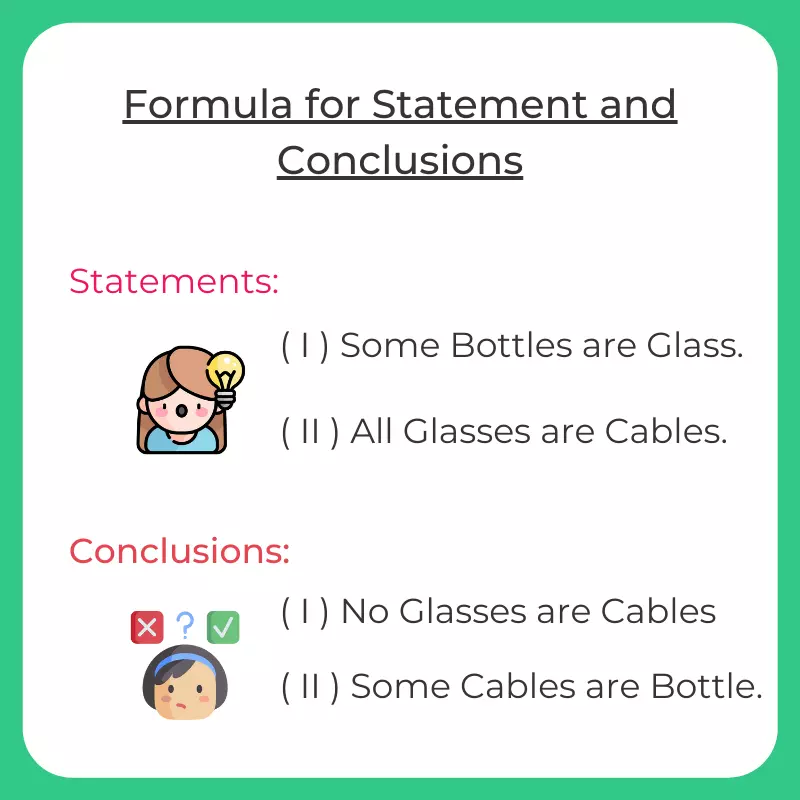Logical Menu
- Number Series
- Coding and Number Series
- Letter and Symbol Series
- Logical Sequence of Words
- Analogy and Classification Pattern
- Statements and Conclusions
- Statements and Assumptions
- Data Sufficiency
- Visual Reasoning
- Cube and Cuboid
- Cube
- Dice
- Directional Senses
- Blood Relations
- Odd Man Out
- Syllogism
- Arrangements
- Seating Arrangements
- Coding Deductive Logic
- Objective Reasoning
- Selection Decision Tables
- Attention to Details
- Inferred Meaning
- Cryprtarithmetic
- Get Off-campus Drive Updates
- Get Hiring Updates
- Contact US
PREPINSTA PRIME
Formulas for Statement and Conclusions

Statement and Conclusion Formulas:-
This page here on contains important Formulas for Statement and Conclusions.
Statement:
A statement consists of a group of words arranged in such a way that they form meaningful sentences. It consists of certain facts, opinions, difficulties or circumstances expressed in words.
Conclusion:
A conclusion is a decision or a judgment made after studying a particular statements. It is a decision or an opinion that is formed after thinking or researching on some facts or statements provided by someone. For instance.
Formulas for Statement and Conclusion
This page here on contains important Formulas for Statement and Conclusions.

Concept :
In a Statement and Conclusions problem, you’re given a set of statements (usually numbered) and a set of conclusions (also numbered). You need to determine whether the given conclusions logically follow from the given statements or not.
Here are a few concepts to consider:
- Valid Deduction (Syllogism): If a conclusion follows logically from the statements given, it is a valid deduction.
- Contradiction: If a conclusion contradicts any of the given statements, it cannot be valid.
- Combination: Sometimes, a valid conclusion can be a combination of two or more statements.
Types of Conclusions:
Conclusions can be classified into different categories based on their logical relationship with the given statements:
- Definitely True Conclusions: These conclusions can be derived directly from the statements without any doubt.
- Definitely False Conclusions: These conclusions are contradicted by the given statements.
- Possibly True Conclusions: These conclusions are supported by the statements, but more information might be needed to confirm their validity.
- Possibly False Conclusions: These conclusions are not supported by the statements, but they are not directly contradicted either.
Prime Course Trailer
Related Banners
Get PrepInsta Prime & get Access to all 200+ courses offered by PrepInsta in One Subscription
Examples on using Formulas for Statement and Conclusions
Example-1
Statement:
Most of the people today choose to travel by train than travel by air as it gives them a better view of the places.
Conclusion:
1. While traveling people wish to enjoy the view of the places.
2. People should circumvent traveling by air.
Options:
A. Only conclusion I follow
B. Only conclusion II follows
C. Either I or II follows
D. Neither I nor II follows
E. Both I and II follow
Correct Answer: D
Explanation:
Conclusion I is not a conclusion it is just an assumption made. So, conclusion I do not follow the statement. Conclusion II is a suggestion given by the writer and not a conclusion. Therefore, neither conclusion I nor conclusion II follows the statement given above.
Example- 2
Statement:
If you work hard constantly, you will never fail.
1. Hard work and continuity is required to get success.
2. Without hard work there is a possibility of success.
Options:
A. Only conclusion I follow
B. Only conclusion II follows
C. Either I or II follows
D. Neither I nor II follows
E. Both I and II follow
Correct Answer: A
Explanation:
Here we can observe that conclusion I can be directly derived from the statement but nothing can be particularly said about conclusion II. Therefore, Only conclusion I follows.
Example – 3
Statement:
All doctors are educated.
Some educated people are musicians.
Conclusions:
a. All doctors are musicians.
b. Some musicians are doctors.
c. All educated people are doctors.
Options:
A. Only conclusion ‘a’ follows.
B. Only conclusion ‘b’ follows.
C. Both conclusions ‘b’ and ‘c’ follow.
D. Only conclusion ‘c’ follows.
E. Neither conclusion follows.
Correct Answer: B
Explanation:
Conclusion b is valid because the second statement establishes a connection between educated people and musicians.
Example – 4
Statements:
No reptiles are insects.
Some insects are small.
Conclusions:
a. All small creatures are insects.
b. No insects are reptiles.
c. Some small creatures are not reptiles.
Options:
A. Only conclusion ‘a’ follows.
B. Only conclusion ‘b’ follows.
C. Both conclusions ‘b’ and ‘c’ follow.
D. Only conclusion ‘c’ follows.
E. Neither conclusion follows.
Correct Answer: C
Explanation:
Conclusion c is valid, as it’s possible that some small creatures could be insects and not reptiles.
Example -5
Statements:
All trees are plants.
All plants need sunlight.
Conclusions:
a. All trees need sunlight.
b. Some plants are trees.
c. All sunlight needs are plants.
Options:
A. Only conclusion ‘a’ follows.
B. Only conclusion ‘b’ follows.
C. Both conclusions ‘a’ and ‘b’ follow.
D. Only conclusion ‘c’ follows.
E. Neither conclusion follows.
Correct Answer: A
Explanation:
Conclusion a is valid because all trees are plants, and according to the second statement, all plants need sunlight.
Also Check Out:
Get over 200+ course One Subscription
Courses like AI/ML, Cloud Computing, Ethical Hacking, C, C++, Java, Python, DSA (All Languages), Competitive Coding (All Languages), TCS, Infosys, Wipro, Amazon, DBMS, SQL and others
- Statements and Assumptions – Questions | Formulas | How to Solve Quickly | Tricks & Shortcuts
- Data Sufficiency – Questions | Formulas | How to Solve Quickly | Tricks & Shortcuts
- Statements and Assumptions –
Questions |
Formulas |
How to Solve Quickly |
Tricks & Shortcuts - Data Sufficiency –
Questions |
Formulas |
How to Solve Quickly |
Tricks & Shortcuts

 Apply For Jobs
Apply For Jobs Get Hiring Updates
Get Hiring Updates




Login/Signup to comment